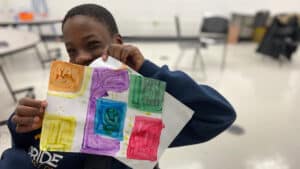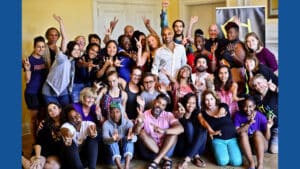STORY #19: OCU’s Intention Room®
Our students are returning to school after an extremely challenging year, one in which many have grappled with extreme stress and trauma. More than ever, we need to support youth, not punish them, when they are faced with difficulty. The Intention Room is one important piece of our effort to reshape school cultures into healing spaces, where students feel loved, encouraged, and empowered. We want to see Intention Rooms adopted across Washington, DC, making DC a model for the rest of the country, with Intention Rooms becoming an integral part of reshaping education.
Intention Rooms are safe spaces supporting students to reflect upon and transform behavioral challenges and prevent truancy, violence, and mental health issues. Under the leadership of OCU facilitators, students explore conflict resolution techniques, art and music therapy, mindfulness, restorative justice circles, and dialogue around the challenges they face in their daily lives within a trauma-informed space. Further, restorative justice circles allow students receiving In-school suspension to analyze the ways their actions did or did not serve their goals, reflect on their innate ability to manage their own behaviors, and define more effective strategies to approach similar situations in the future.
The concept of the Intention Room emerged through OCU educators’ frustration with the severe lack of healing and restorative practices available for students. In a moment of sheer brilliance, Fly By Light Senior Facilitator, Princess Best, coined the term amidst discussions about how we could expand our impact within schools. Shortly after, the DC Council enacted the Student Fair Access to School Act, legislation that limits the amount of time that students can be suspended. Intention Rooms offer an intentional, trauma-informed alternative to punitive or exclusionary disciplinary practices (including suspension); one that builds students’ self-esteem, sense of agency, and empowers them to build healthy habits and lead thriving lives.
In an effort to expand the adoption of Intention Rooms across the city (and country) we’ve developed an Intention Room Toolkit and accompanying training to equip any school with the best practices and framework to establish their own Intention Room. If you’re interested in learning more about bringing Intention Rooms to your school, I invite you to email us at
~ Aaron Shneyer, OCU Managing Director
Please keep reading for some excerpts from the Intention Room Toolkit:

Why Intention Rooms?
Punitive and exclusionary methods of discipline like detention and suspension result in decreased self-esteem, decreased motivation, and lower graduation rates. Suspension and the resulting loss of instructional time have long-term negative consequences for students. Research has shown that suspensions do little to change student behavior, but they do increase the likelihood of students dropping out of school or becoming involved in the criminal justice system. In fact, exclusionary methods of discipline often have the opposite effect of exacerbating school issues and further alienating the student from the school environment.
The “school to prison pipeline” is a national trend where students are pushed out of the school system and into the juvenile and criminal justice systems. The pipeline is further fueled by “zero-tolerance policies” and the presence of police officers in school. A significant number of suspensions are unrelated to school safety — they are applied for minor, vaguely defined behavior infractions such as “willful defiance.” Students disciplined for willful defiance have been removed from school for chewing gum, talking in class, or not wearing a school uniform.
As a Restorative Justice-centered alternative to in-school suspension, the Intention Room™ delivers an effective strategy for preventing long-term out-of-school suspension, truancy, violence, mental health issues, and offers the potential to interrupt the school to prison pipeline. These spaces make use of the Intention Room™ associated practices to support the well-being of students and of the school community, including Restorative Practices.
Restorative Practices provide a pathway to strengthen community, build relationships among students and between students and staff, and increase the safety and productivity of the learning environment.
Intention Room Facilitator(s)
An important element of a successful Intention Room is the careful hiring and training of the facilitators who will provide direct support to students. These facilitators will need to build relationships of trust with all members of the school community, especially students. Ideally, facilitators will be available in the Intention Room™ during school hours. However, due to many factors including financial needs, schools may choose to have a facilitator(s) available on specific days/times or on an on-call basis. Facilitators need to be highly skilled self-reflective practitioners with training in the following areas:
- Trauma-Informed Practice
- Conflict Resolution
- Restorative Justice
- Non-Violent Communication
- Cultural Humility
- Arts Expression
- Mindfulness
The Physical Space
The physical environment is an important element for a successful Intention Room. The space needs to feel inviting, calming, and comfortable so that students can feel safe to address their intense emotions or address current conflicts. It is important to understand that each school’s culture and context are different. Our tool kit provides suggestions for establishing an Intention Room that can uniquely meet the needs of your school.


Intention Room in the News
One Common Unity provides professional development training for educators in all of the above areas. Find out more: www.onecommonunity.org/workshops or email






